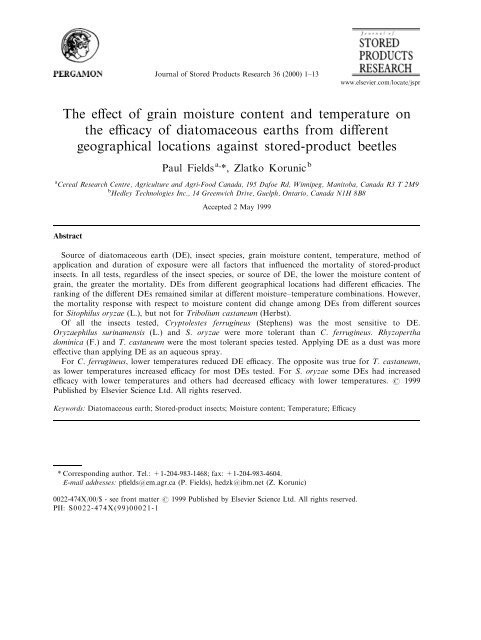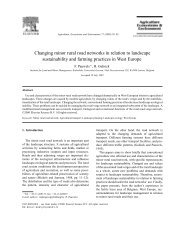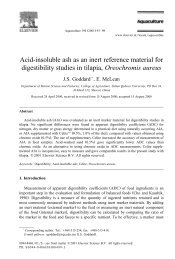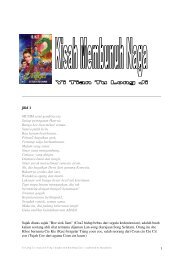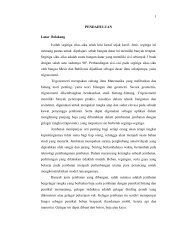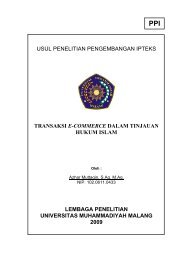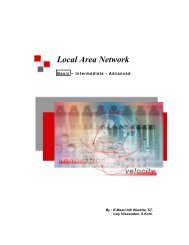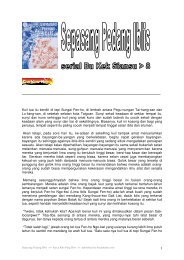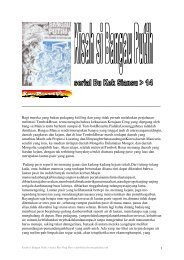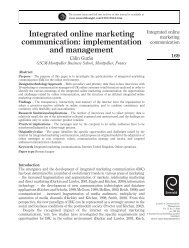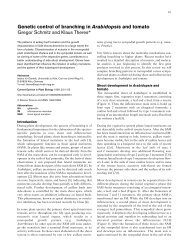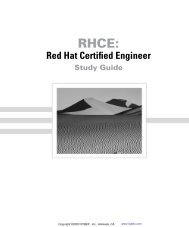The effect of grain moisture content and ... - Directory UMM
The effect of grain moisture content and ... - Directory UMM
The effect of grain moisture content and ... - Directory UMM
You also want an ePaper? Increase the reach of your titles
YUMPU automatically turns print PDFs into web optimized ePapers that Google loves.
<strong>The</strong> e€ect <strong>of</strong> <strong>grain</strong> <strong>moisture</strong> <strong>content</strong> <strong>and</strong> temperature on<br />
the e cacy <strong>of</strong> diatomaceous earths from di€erent<br />
geographical locations against stored-product beetles<br />
Paul Fields a, *, Zlatko Korunic b<br />
a Cereal Research Centre, Agriculture <strong>and</strong> Agri-Food Canada, 195 Dafoe Rd, Winnipeg, Manitoba, Canada R3 T 2M9<br />
b Hedley Technologies Inc., 14 Greenwich Drive, Guelph, Ontario, Canada N1H 8B8<br />
Abstract<br />
Journal <strong>of</strong> Stored Products Research 36 (2000) 1±13<br />
Accepted 2 May 1999<br />
Source <strong>of</strong> diatomaceous earth (DE), insect species, <strong>grain</strong> <strong>moisture</strong> <strong>content</strong>, temperature, method <strong>of</strong><br />
application <strong>and</strong> duration <strong>of</strong> exposure were all factors that in¯uenced the mortality <strong>of</strong> stored-product<br />
insects. In all tests, regardless <strong>of</strong> the insect species, or source <strong>of</strong> DE, the lower the <strong>moisture</strong> <strong>content</strong> <strong>of</strong><br />
<strong>grain</strong>, the greater the mortality. DEs from di€erent geographical locations had di€erent e cacies. <strong>The</strong><br />
ranking <strong>of</strong> the di€erent DEs remained similar at di€erent <strong>moisture</strong>±temperature combinations. However,<br />
the mortality response with respect to <strong>moisture</strong> <strong>content</strong> did change among DEs from di€erent sources<br />
for Sitophilus oryzae (L.), but not for Tribolium castaneum (Herbst).<br />
Of all the insects tested, Cryptolestes ferrugineus (Stephens) was the most sensitive to DE.<br />
Oryzaephilus surinamensis (L.) <strong>and</strong> S. oryzae were more tolerant than C. ferrugineus. Rhyzopertha<br />
dominica (F.) <strong>and</strong> T. castaneum were the most tolerant species tested. Applying DE as a dust was more<br />
e€ective than applying DE as an aqueous spray.<br />
For C. ferrugineus, lower temperatures reduced DE e cacy. <strong>The</strong> opposite was true for T. castaneum,<br />
as lower temperatures increased e cacy for most DEs tested. For S. oryzae some DEs had increased<br />
e cacy with lower temperatures <strong>and</strong> others had decreased e cacy with lower temperatures. # 1999<br />
Published by Elsevier Science Ltd. All rights reserved.<br />
Keywords: Diatomaceous earth; Stored-product insects; Moisture <strong>content</strong>; Temperature; E cacy<br />
* Corresponding author. Tel.: +1-204-983-1468; fax: +1-204-983-4604.<br />
E-mail addresses: p®elds@em.agr.ca (P. Fields), hedzk@ibm.net (Z. Korunic)<br />
0022-474X/00/$ - see front matter # 1999 Published by Elsevier Science Ltd. All rights reserved.<br />
PII: S0022-474X(99)00021-1<br />
www.elsevier.com/locate/jspr
2<br />
1. Introduction<br />
<strong>The</strong> choice <strong>of</strong> insecticides that may be used on <strong>and</strong> around stored food commodities is<br />
limited by strict requirements to ensure safety for consumers, <strong>grain</strong>-h<strong>and</strong>lers <strong>and</strong> livestock<br />
(White <strong>and</strong> Leesch, 1995). <strong>The</strong> use <strong>of</strong> synthetic pesticides is under increasing scrutiny because<br />
<strong>of</strong> problems with environmental contamination, atmospheric ozone-depletion (i.e., methyl<br />
bromide), potential carcinogens, concern over residues in commodities, exposure to applicators,<br />
environmental <strong>and</strong> work space restriction, resistance in pests, <strong>and</strong> general consumer aversion to<br />
the use <strong>of</strong> chemicals. <strong>The</strong>refore, there is a growing need for nonchemical pest control methods.<br />
Diatomaceous earth (DE) is used as an alternative to synthetic insecticides because it has<br />
low mammalian toxicity, does not break down rapidly <strong>and</strong> does not a€ect end-use quality<br />
(Desmarchelier <strong>and</strong> Dines, 1987; Korunic et al., 1996). <strong>The</strong> rat oral lethal concentration (LC50)<br />
<strong>of</strong> silicon dioxide, the major constituent <strong>of</strong> DE is 3160 mg/kg (NIOSH, 1977). DE consists <strong>of</strong><br />
prehistoric skeletons <strong>of</strong> either freshwater or marine organisms, predominantly single-cell algae<br />
called diatoms. Most DEs are 70±90% amorphous silicon dioxide with the balance being made<br />
up <strong>of</strong> inorganic oxides <strong>and</strong> salts (Quarles, 1992; Quarles <strong>and</strong> Winn, 1996; Korunic, 1997). DE<br />
absorbs the cuticular lipids <strong>of</strong> insects, causing death by desiccation (Ebeling, 1971).<br />
Temperature <strong>and</strong> <strong>moisture</strong> play an important role in the population dynamics <strong>of</strong> storedproduct<br />
insect pests. An increase in the <strong>moisture</strong> <strong>content</strong> <strong>of</strong> <strong>grain</strong> results in a decrease in the<br />
e cacy <strong>of</strong> synthetic insecticides, as they degrade faster (Snelson, 1987). Higher <strong>grain</strong> <strong>moisture</strong><br />
<strong>content</strong>s also reduce e cacy <strong>of</strong> DE, because the mode <strong>of</strong> action <strong>of</strong> DE is due to desiccation<br />
(Carlson <strong>and</strong> Ball, 1962; La Hue, 1965; Maceljski <strong>and</strong> Korunic, 1972; Desmarchelier <strong>and</strong><br />
Dines, 1987; Aldryhim, 1990, 1993). However, these tests were conducted with only a single<br />
source <strong>of</strong> DE. Recent research has shown that DEs from di€erent geographical locations can<br />
have di€erent insecticidal activity, diatom species, pH, density, particle size distribution,<br />
internal surface area, lipid adsorption capability <strong>and</strong> e€ects on <strong>grain</strong> bulk density (Korunic,<br />
1997).<br />
<strong>The</strong> objective <strong>of</strong> this study was to determine if DEs from various geographical sources <strong>and</strong><br />
formulations reacted di€erently to <strong>grain</strong> <strong>moisture</strong> <strong>content</strong>. As temperature plays an important<br />
role in the biology <strong>of</strong> stored-product insects <strong>and</strong> the e€ectiveness <strong>of</strong> synthetic insecticides, we<br />
also determined the e€ect <strong>of</strong> temperature on DE e cacy. For the control <strong>of</strong> Cryptolestes<br />
ferrugineus (Stephens) with certain DEs, it is recommended that 100 ppm be applied to wheat,<br />
14% <strong>moisture</strong> <strong>content</strong> (m.c.) or lower, at harvest. Our ®nal objective was to determine if C.<br />
ferrugineus could be controlled with higher concentrations <strong>of</strong> DE in wheat that is cooler than<br />
freshly harvested <strong>grain</strong> <strong>and</strong> moister than 14% m.c.<br />
2. Materials <strong>and</strong> methods<br />
2.1. Diatomaceous earths<br />
P. Fields, Z. Korunic / Journal <strong>of</strong> Stored Products Research 36 (2000) 1±13<br />
<strong>The</strong> diatomaceous earths are described in Table 1. Protect-It TM (Korunic <strong>and</strong> Fields, 1995)<br />
was obtained from Hedley Technologies Ltd, 5160 Explorer Drive, Unit 20, Mississauga,<br />
Ontario, L4W 4T7, Canada. Insecto 1 was obtained from Natural Insect Products Inc., North
Table 1<br />
<strong>The</strong> description <strong>of</strong> the di€erent DEs used in the tests 1<br />
DE Source Diatom type Additives SiO 2<br />
(%)<br />
Protect-It TM<br />
Maximum crystalline SiO 2<br />
(%)<br />
Median particle size<br />
(mm)<br />
USA Marine 10% silica aerogel 87 3 6.6 66.3<br />
Diaherb Macedonia Marine None > 80 4 ± 2<br />
100<br />
Dryacide 1<br />
Australia Freshwater 0.1±0.2% silica aerogel 94 1 11.1 29.2<br />
Insecto 1<br />
USA Marine 10% bait 87 3 8.2 57.1<br />
Japan 3 Japan Marine None 80 NA 22.1 28.1<br />
Perma Guard 1 USA Freshwater None 93 1 11.7 42.7<br />
Celite 209 USA Marine None 87 3 8.2 57.1<br />
Respirable dust<br />
(% less than 10 mm)<br />
1<br />
SiO2 taken from insecticide label, crystalline SiO2 taken from material data safety sheet <strong>and</strong> particle size was determined using the Cilas granulometre<br />
715 F155 method, NA=not available.<br />
2<br />
All particles less than 4 mm.<br />
P. Fields, Z. Korunic / Journal <strong>of</strong> Stored Products Research 36 (2000) 1±13 3
4<br />
Eckho€ Street, Orange, CA 92668, USA. <strong>The</strong> marine DE Japan 3 was obtained from Ithochu<br />
Agri-System Co. Ltd, Japan. Diaherb was produced by aqueous sedimentation to select the<br />
®nest particles from a DE from Macedonia (Korunic, 1997). Dryacide 1 (Hedges <strong>and</strong> Belford,<br />
1985) was obtained from Dryacide Australia PTY Ltd, P.O. Box 38, Maddington, Western<br />
Australia, 6019, Australia. Perma-Guard 1 D-10 was obtained from Perma Guard Inc., PO<br />
Box 25282, Albuquerque, NM 87125, USA. Celite 209 was obtained from Celite Corp., P.O.<br />
Box 519, Lompoc, CA 93438, USA, <strong>and</strong> was used for the scanning electronic microscope<br />
work. Since the completion <strong>of</strong> these tests, Protect-It TM <strong>and</strong> Dryacide 1 have changed their<br />
source <strong>of</strong> DE.<br />
2.2. Test insects<br />
<strong>The</strong> species tested were adults <strong>of</strong>: the rusty <strong>grain</strong> beetle, C. ferrugineus; the rice weevil,<br />
Sitophilus oryzae (L.); the sawtoothed <strong>grain</strong> beetle, Oryzaephilus surinamensis (L.); the lesser<br />
<strong>grain</strong> borer, Rhyzopertha dominica (F.) <strong>and</strong> the red ¯our beetle Tribolium castaneum (Herbst).<br />
Insects were reared at 30218C <strong>and</strong> 6525% r.h. in the dark on whole wheat for S. oryzae <strong>and</strong><br />
R. dominica, whole wheat <strong>and</strong> 5% (by weight) wheat germ for C. ferrugineus, wheat ¯our <strong>and</strong><br />
5% (by weight) brewer's yeast for T. castaneum, or rolled oats <strong>and</strong> 5% (by weight) brewer's<br />
yeast for O. surinamensis. Unsexed, adults <strong>of</strong> mixed ages were used in all experiments. Insects<br />
were obtained from cultures maintained in the laboratory for at least three years, with no<br />
history <strong>of</strong> exposure to insecticides.<br />
2.3. Bioassay<br />
P. Fields, Z. Korunic / Journal <strong>of</strong> Stored Products Research 36 (2000) 1±13<br />
Hard Red Spring wheat was used in all bioassays. Moisture <strong>content</strong> was measured using a<br />
dielectric <strong>moisture</strong> meter (model 919, Labtronics, Winnipeg) following AACC (1995) Method<br />
44-11. To adjust <strong>moisture</strong> <strong>content</strong>, water was added to wheat, <strong>and</strong> the <strong>grain</strong> in each jar was<br />
mixed on a mechanical roller (Norton, Chemical Process Product Division, Akron, OH, USA)<br />
for 30 min. To maintain the <strong>moisture</strong> <strong>content</strong>, <strong>grain</strong> was held in hermetically closed jars at<br />
258C for seven days.<br />
After adding di€erent concentrations <strong>of</strong> DE (0, 100, 200, 300, 400 or 600 ppm) to<br />
preconditioned <strong>grain</strong> in each jar, lids were closed tightly <strong>and</strong> jars were rolled by h<strong>and</strong> for one<br />
minute. Grain was then divided into 20-g lots <strong>and</strong> placed in glass vials (35 ml). Test insects, 50<br />
(C. ferrugineus ) or 25 (other species) adults, were introduced into vials. Each species was tested<br />
separately. <strong>The</strong> vials were held at constant temperature (15, 20, or 308C) <strong>and</strong> relative humidity<br />
(65±70% r.h.) for one or two durations before mortality was assessed. Durations were chosen<br />
as a function <strong>of</strong> the insect's tolerance to DE, determined in previous studies (Korunic 1997,<br />
1998). <strong>The</strong>re were ®ve replicate vials for each assessment. Untreated <strong>grain</strong> (0 ppm) served as a<br />
control.<br />
For the trial with C. ferrugineus at 15 <strong>and</strong> 208C, relative humidity was maintained using<br />
saturated salt solutions: CaCl2, r.h.=35±33%, <strong>grain</strong> m.c.=12%; NaCl, r.h.=76%, <strong>grain</strong><br />
m.c.=15% <strong>and</strong> KCl, r.h.=86%, <strong>grain</strong> m.c.=17%. <strong>The</strong>re were three replicate vials with 25<br />
insects/replicate. For the slurry application, <strong>grain</strong> was spread out to one kernel thickness,<br />
sprayed with a DE at 15% aqueous solution (by weight) using an aerosol applicator (Crown
Industrial Products, 1500 McConnell Rd, Woodstock, IL 60098, USA) placed in a jar <strong>and</strong><br />
rolled by h<strong>and</strong> for 30 s.<br />
2.4. Scanning electron micrographs<br />
Adult insects were placed in wheat (14% m.c., 600 ppm Celite 209), <strong>and</strong> held at 308C. After<br />
one to six days, dead insects were removed from the <strong>grain</strong> <strong>and</strong> glued to SEM stubs. Insects<br />
were dried in a desiccator at 0% r.h. for 48 h, <strong>and</strong> coated with gold using a sputter coater<br />
(Polaron) to reduce charging e€ects. <strong>The</strong>ir ventral abdomens were photographed at 845 to<br />
1690 power magni®cation using a scanning electron microscope (Philips 515).<br />
3. Results<br />
P. Fields, Z. Korunic / Journal <strong>of</strong> Stored Products Research 36 (2000) 1±13 5<br />
In all the tests run (Tables 2, 3 <strong>and</strong> 4, Figs. 1 <strong>and</strong> 2), regardless <strong>of</strong> the species, or source <strong>of</strong><br />
DE, the lower the <strong>moisture</strong> <strong>content</strong>, the greater the mortality. For example, T. castaneum <strong>and</strong><br />
Table 2<br />
<strong>The</strong> mortality <strong>of</strong> two insect species held at various temperature <strong>and</strong> <strong>moisture</strong> conditions on wheat treated with six<br />
di€erent diatomaceous earths for ®ve days at 400 ppm for S. oryzae <strong>and</strong> at 600 ppm for T. castaneum<br />
Mortality2SEM (%) 1<br />
208C 308C<br />
ANOVA 2<br />
Insect DE Source 12% m.c. 14% m.c. 12% m.c. 14% m.c. m.c. T m.c. T<br />
Sitophilus oryzae Protect-It TM<br />
9921 a 6026 a 9723 a 4127 a NS<br />
Diaherb 9523 a 6727 a 9422 a 4124 a NS<br />
Dryacide 1<br />
78210 b 1524 bc 9621 a 3327 a NS<br />
Insecto 1<br />
7426 b 2925 b 9627 a 3226 a<br />
Japan 3 4428 c 1926 bc 4629 c 423 b NS NS<br />
Perma Guard 1 2923 c 721c 7726 b 221 b<br />
Untreated 222 d 020 d 1727 d 221 b NS<br />
Tribolium castaneum Protect-It TM<br />
9224 a 7928 a 7824 a 49217 a NS NS<br />
Diaherb 9323 a 7225 a 7527 a 4229 a NS<br />
Dryacide 1<br />
6825 b 3624 b 3127 b 622 b NS<br />
Insecto 1<br />
6324 b 1823 c 6629 a 30212 ab NS NS<br />
Japan 3 5524 b 1223 c 3026 b 121 b NS<br />
Perma Guard 1 2125 c 922 c 623 c 121 b NS<br />
Untreated 020 d 121 d 020 d 020 b NS NS NS<br />
1<br />
For a given species, <strong>moisture</strong> <strong>and</strong> temperature combination, means followed by di€erent letters are signi®cantly<br />
di€erent pE0.05 Student±Newman±Keuls test.<br />
2<br />
A 2-way ANOVA was run speci®cally for each DE; NS=not signi®cant p > 0.05, =pE0.05, =pE0.01,<br />
=pE0.001, =pE0.0001, for analysis, control mortality was corrected using Abbot's formula, n =5.
6<br />
Table 3<br />
<strong>The</strong> mortality <strong>of</strong> C. ferrugineus held at various temperature <strong>and</strong> <strong>moisture</strong> conditions on wheat treated with Protect-<br />
It TM diatomaceous earth<br />
Duration<br />
<strong>of</strong> exposure<br />
(days)<br />
Dose<br />
(ppm)<br />
P. Fields, Z. Korunic / Journal <strong>of</strong> Stored Products Research 36 (2000) 1±13<br />
Mortality2SEM<br />
(%) 1<br />
158C 208C<br />
ANOVA 2<br />
12% m.c. 15% m.c. 17% m.c. 12% m.c. 15% m.c. 17% m.c. m.c. T m.c. T<br />
3 0 020 a 020 a 323 a 020 a 020 a 020 a NS NS NS<br />
100 1523 b 521 b 121 a 4124 b 2923 b 323 a<br />
200 8921 c 4321 c 4723 b 9521 c 8025 c 8921 b<br />
300 9921 d 8721 d 5721 c 10020 c 9521 d 10020 c<br />
7 0 1121 a 921 a 822 a 020 a 523 a 721 a NS NS NS<br />
100 7721 b 2822 b 2822 b 7625 b 6127 b 2124 b<br />
200 10020 c 10020 c 9921 c 10020 c 10020 c 9622 c NS NS<br />
300 10020 c 10020 c 10020 c 10020 c 10020 c 10020 c NS NS NS<br />
1<br />
For a given duration, <strong>moisture</strong> <strong>and</strong> temperature combination, means followed by di€erent letters are signi®cantly<br />
di€erent pE0.05 Student±Newman±Keuls test.<br />
2<br />
A 2-way ANOVA was run for each DE source; NS=not signi®cant p > 0.05, =pE0.05, =pE0.01,<br />
=pE0.001, =pE0.0001, for the analysis control mortality was corrected using Abbot's formula, n =3.<br />
Fig. 1. <strong>The</strong> mortality <strong>of</strong> S. oryzae held at 308C on wheat treated with three diatomaceous earths at 300 ppm.<br />
Mortality <strong>of</strong> insects on untreated wheat was less than 4%, n =5.
Table 4<br />
<strong>The</strong> mortality <strong>of</strong> four insect species held at 258C at various <strong>moisture</strong> <strong>content</strong>s on wheat treated with Protect-It TM diatomaceous earth at 300 ppm.<br />
Insects held on untreated wheat had less than 2% mortality<br />
Insect Duration <strong>of</strong> exposure<br />
(days)<br />
Mortality2SEM<br />
(%) 1<br />
11.8% m.c. 13.9% m.c. 15.0% m.c.<br />
ANOVA 2<br />
Dust Spray Dust Spray Dust Spray m.c. Dust vs Spray m.c. app.<br />
Cryptolestes ferrugineus 1 9223 b 57215 10020 a 4724 7525 a 5526 NS NS<br />
2 10020 a ± 10020 a ± 10020 b ± NS ± ±<br />
Oryzaephilus surinamensis 5 10020 a 8823 a 9222 a 7922 a 7123 a 4524 a NS<br />
9 9822 a 9821 b 9921 b 9421 b 9523 b 8321 b NS<br />
Sitophilus oryzae 5 9523 a 5626 7423 b 8923 5322 a 3324 a<br />
9 9722 a 9722 9921 a 8024 9922 b 9521 b<br />
Rhyzopertha dominica 5 7223 a ± 3927 a ± 1722 a ± ± ±<br />
14 9023 b ± 6825 b ± 5825 b ± ± ±<br />
1<br />
For a given species, <strong>moisture</strong> <strong>and</strong> application combination, means followed by di€erent letters are signi®cantly di€erent pE0.05 Student±<br />
Newman±Keuls test.<br />
2<br />
A 2-way ANOVA was run for each row; NS=not signi®cant p > 0.05, =pE0.05, =pE0.01, =pE0.001, =pE0.0001, n =5.<br />
P. Fields, Z. Korunic / Journal <strong>of</strong> Stored Products Research 36 (2000) 1±13 7
8<br />
P. Fields, Z. Korunic / Journal <strong>of</strong> Stored Products Research 36 (2000) 1±13<br />
Fig. 2. <strong>The</strong> mortality <strong>of</strong> T. castaneum held at 308C on wheat treated with three diatomaceous earths at 300 ppm.<br />
Mortality <strong>of</strong> insects on untreated wheat was less than 4%, n =5.<br />
S. oryzae were essentially una€ected by DE in wheat with 16% m.c., but 40±100% <strong>of</strong> adults<br />
died in wheat with 10% m.c., at the longest duration <strong>of</strong> exposure (Figs. 1 <strong>and</strong> 2). For S.<br />
oryzae, di€erent DEs reacted di€erently to <strong>moisture</strong>, as the slopes <strong>of</strong> the mortality vs m.c.<br />
curves are di€erent <strong>and</strong> there is a signi®cant interaction between m.c. <strong>and</strong> DE source (Fig. 1,<br />
2-way ANOVA, duration=3 d, for DE source p < 0.0001, for m.c. p < 0.0001, for interaction<br />
DE source <strong>and</strong> m.c. p = 0.0007). In the test with S. oryzae with six di€erent DE sources, there<br />
was also a signi®cant interaction between m.c. <strong>and</strong> DE (Table 2, 2-way ANOVA,<br />
temperature=208C, for DE source p < 0.0001, for m.c. p < 0.0001, for interaction DE source<br />
<strong>and</strong> m.c. p = 0.011; temperature=308C, for DE source p < 0.0001, for m.c. p < 0.0001, for<br />
interaction DE source <strong>and</strong> m.c. p = 0.0001). For T. castaneum, there were no signi®cant<br />
interactions between DE source <strong>and</strong> m.c. (Table 2, 2-way ANOVA, temperature=208C, for<br />
DE source p < 0.0001, for m.c. p < 0.0001, for interaction DE source <strong>and</strong> m.c. p = 0.062;<br />
temperature=308C, for DE source p < 0.0001, for m.c. p < 0.0001, for interaction DE source<br />
<strong>and</strong> m.c. p = 0.71). For the experiments that ranged from 10 to 16% m.c. (Figs. 1 <strong>and</strong> 2), we<br />
did not test S. oryzae at 7 d or T. castaneum at either duration, because there were treatments<br />
that caused either 0 or 100% mortality, which would constrain the slopes <strong>and</strong> make it<br />
impossible to determine if there was an interaction between DE source <strong>and</strong> m.c.<br />
Di€erent DEs had di€erent e cacies. Depending upon the conditions, there was up to a<br />
70% di€erence in mortality between DE sources (Table 2). However, the ranking between the<br />
DEs remained similar at di€erent <strong>moisture</strong>±temperature combinations (Table 2, Figs. 1 <strong>and</strong> 2).<br />
For C. ferrugineus, lower temperatures caused signi®cant reductions in e cacy (Table 3).<br />
<strong>The</strong> opposite was true for T. castaneum, as lower temperatures caused increased e cacy for<br />
most DEs tested (Table 2). For S. oryzae some DE sources showed increased e cacy with<br />
lower temperatures, <strong>and</strong> others showed decreased e cacy with lower temperatures (Table 2).
P. Fields, Z. Korunic / Journal <strong>of</strong> Stored Products Research 36 (2000) 1±13 9<br />
Of all the insects tested, C. ferrugineus was the most sensitive to DE. <strong>The</strong>re was 100%<br />
mortality after two days even in the moistest <strong>grain</strong> at 300 ppm (Table 4). Oryzaephilus<br />
surinamensis <strong>and</strong> S. oryzae were more tolerant than C. ferrugineus, with the same or less<br />
mortality after ®ve days. Rhyzopertha dominica was even more tolerant with only 17%<br />
mortality after ®ve days at 15% m.c., whereas O. surinamensis had 71% <strong>and</strong> S. oryzae had<br />
53% mortality. Tribolium castaneum had greater survival than S. oryzae in tests with three<br />
di€erent DEs (Figs. 1 <strong>and</strong> 2). <strong>The</strong> method <strong>of</strong> application also a€ected mortality. Dusting was<br />
more e€ective than spraying (Table 4). Tribolium castaneum had noticeably less DE attached to<br />
its cuticle than C. ferrugineus, S. oryzae <strong>and</strong> R. dominica (Fig. 3).<br />
Fig. 3. Scanning electron micrographs <strong>of</strong> the ventral surface <strong>of</strong> abdomens <strong>of</strong> insects held in wheat with 600 ppm<br />
diatomaceous earth (Celite 209) for various durations.
10<br />
4. Discussion<br />
P. Fields, Z. Korunic / Journal <strong>of</strong> Stored Products Research 36 (2000) 1±13<br />
<strong>The</strong>re are many examples <strong>of</strong> increased <strong>moisture</strong> <strong>content</strong> or relative humidity reducing the<br />
e€ectiveness <strong>of</strong> diatomaceous earth <strong>and</strong> other inert dusts (Nair, 1957; Carlson <strong>and</strong> Ball, 1962;<br />
La Hue, 1965; Ebeling 1971; Maceljski <strong>and</strong> Korunic, 1972; Desmarchelier <strong>and</strong> Dines, 1987;<br />
Aldryhim, 1990, 1993). For example, an increase in relative humidity from 40 to 60%, which<br />
corresponds to 9 <strong>and</strong> 12% m.c. in wheat (Pixton <strong>and</strong> Warburton, 1971), causes a three-fold<br />
increase in LD50 for Dryacide 1 against Tribolium confusum Jacquelin du Val (confused ¯our<br />
beetle) <strong>and</strong> S. oryzae (Aldryhim 1990). We also saw decreases in e€ectiveness with higher <strong>grain</strong><br />
<strong>moisture</strong> <strong>content</strong>s with all DEs tested. Some <strong>of</strong> these results were similar to those seen in other<br />
studies. In our tests with Dryacide 1 at 300 ppm, S. oryzae had 75% mortality at 12% m.c.<br />
after seven days <strong>and</strong> 308C, <strong>and</strong> Aldryhim (1990) estimated a LD 50 <strong>of</strong> 369 (307±421) ppm under<br />
similar temperature <strong>and</strong> humidity levels after seven days. <strong>The</strong> increased e cacy under dryer<br />
conditions is due to increased dessication, which is the mode <strong>of</strong> action <strong>of</strong> DE (Ebeling, 1971).<br />
DE from di€erent geological sources, or even from the same location have di€erent physical<br />
properties (SiO 2 <strong>content</strong>, tapped density, oil absorbency, particle size <strong>and</strong> pH) that are<br />
correlated to their insecticidal e cacy against stored-product insects (Korunic, 1997, 1998).<br />
Comparison among DEs are di cult because there is signi®cant variation in insecticidal<br />
activity from the same geographical source, <strong>and</strong> only small quantities <strong>of</strong> DE are used for<br />
laboratory testing. For example, unlike our results, Dryacide 1 was shown to have greater<br />
e cacy than Insecto 1 <strong>and</strong> similar e cacy as Protect-It TM in another study (Bhadriraju<br />
Subramanyam, 1999, personal communication). Also, the rank, among species did not change<br />
with the di€erent DEs. Thus, blending DEs would not produce a DE that was e€ective against<br />
a broad range <strong>of</strong> stored-product insects.<br />
If there was no interaction between DE source <strong>and</strong> <strong>moisture</strong> <strong>content</strong>, then it would be<br />
su cient to determine the <strong>moisture</strong> response for a single DE source to determine how all DEs<br />
would respond to changes in <strong>grain</strong> <strong>moisture</strong> <strong>content</strong>. Granted, di€erent DEs would require<br />
di€erent concentrations, but the rate <strong>of</strong> change in mortality with respect to <strong>moisture</strong> <strong>content</strong><br />
would be the same <strong>and</strong> independent <strong>of</strong> the DE source. One problem with a study <strong>of</strong> this nature<br />
is that mortality is constrained between 0 <strong>and</strong> 100%. <strong>The</strong>re are two solutions to this problem;<br />
choose conditions which produce mortalities between these values, or test a range <strong>of</strong><br />
concentrations <strong>and</strong> estimate the LD50 or the LD95, variables that are not constrained. We had<br />
some data sets that had all mortalities between 0 <strong>and</strong> 100%, <strong>and</strong> we concluded that for S.<br />
oryzae DE source <strong>and</strong> <strong>moisture</strong> interacted, whereas there was no interaction for T. castaneum.<br />
More detailed work with estimates <strong>of</strong> LD 50 should be done to con®rm this work, <strong>and</strong> to<br />
determine what is the response <strong>of</strong> other insect species on di€erent commodities.<br />
<strong>The</strong> e€ect <strong>of</strong> temperature on DE is less well studied than the e€ect <strong>of</strong> <strong>moisture</strong> <strong>content</strong>.<br />
Rhyzopertha dominica <strong>and</strong> S. granarius are approximately twice as sensitive to Dryacide 1 at<br />
308C than at 208C, but T. confusum is slightly less sensitive to Dryacide 1 at the higher<br />
temperatures (Aldryhim, 1990, 1993). Our studies showed that increased temperatures caused<br />
C. ferrugineus to be more susceptible <strong>and</strong> T. castaneum to be slightly less susceptible to DE.<br />
Sitophilus oryzae needs further study at various temperatures, as temperature e€ects were not<br />
consistent among DEs.<br />
Other insecticides, such as the organophosphates, have positive temperature coe cients
P. Fields, Z. Korunic / Journal <strong>of</strong> Stored Products Research 36 (2000) 1±13 11<br />
(Snelson, 1987), becoming more toxic at higher temperatures. This is underst<strong>and</strong>able, as most<br />
chemical <strong>and</strong> biochemical reactions are faster at higher temperatures; usually the reaction<br />
increases two to three times for every 108C (Mordue et al., 1980). A few insecticides such as<br />
DDT (Osborne, 1985), pyrethrum <strong>and</strong> the many <strong>of</strong> the pyrethroids (Snelson, 1987) usually<br />
have negative temperature coe cients, becoming more toxic at lower temperatures.<br />
<strong>The</strong>re are several possible reasons why temperature would a€ect the e cacy <strong>of</strong> DE <strong>and</strong> why<br />
some insects have a positive temperature coe cient while others have a negative coe cient.<br />
Increased temperature would increase insect movement, causing increased contact with the DE<br />
<strong>and</strong> greater cuticular damage. Higher temperatures <strong>and</strong> increased movement would also<br />
increase water loss via the spiracles due to increased respiration. Losses via the spiracles are<br />
estimated to be three times greater than losses <strong>of</strong> water through the cuticle for a desert<br />
tenebrionid (Zachariassen, 1991). Also rate <strong>of</strong> cuticular transpiration rises only slightly with<br />
temperature until the transition temperature which for most insects is above 308C<br />
(Wigglesworth, 1972). However, increased temperature would also increase feeding <strong>and</strong><br />
therefore <strong>moisture</strong> replacement through the food <strong>and</strong> production <strong>of</strong> metabolic water. <strong>The</strong><br />
synthesis <strong>of</strong> cuticular waxes may be faster at higher temperatures because <strong>of</strong> temperature<br />
e€ects on the biochemical pathways. However, there may be other overriding factors. In the<br />
cockroach, the synthesis <strong>of</strong> cuticular waxes is under hormonal control (Treherne <strong>and</strong> Willmer,<br />
1975), <strong>and</strong> it is possible that damaging the cuticle or low water levels in the insect could trigger<br />
the production <strong>of</strong> cuticular waxes, causing changes in the cuticular waxes independent <strong>of</strong> the<br />
temperature. Unlike the synthetic insecticides, DE is inert <strong>and</strong> does not degrade in a<br />
temperature-dependent fashion. Within a <strong>grain</strong> bulk, the relative humidity will change slightly<br />
with temperature. For stored wheat there is about a 3% reduction in relative humidity for each<br />
108C increase in temperature (Pixton <strong>and</strong> Warburton, 1971). However, these changes would be<br />
too small to be responsible for the e€ects we observed.<br />
Stored-product insects show a wide range <strong>of</strong> susceptibility to DE (Carlson <strong>and</strong> Ball, 1962;<br />
Desmarchelier <strong>and</strong> Dines, 1987; White <strong>and</strong> Loschiavo, 1989; Aldryhim, 1990, 1993). Though<br />
there are di€erent rankings among these studies, overall the rankings are with the most to the<br />
least susceptible: Cryptolestes spp, Oryzaephilus spp, Sitophilus spp, R. dominica <strong>and</strong> Tribolium<br />
spp. In our tests C. ferrugineus > O. surinamensis=S. oryzae > R. dominica/T. castaneum in<br />
order <strong>of</strong> tolerance. A few studies have addressed why there are di€erent susceptibilities among<br />
species. Nair (1957) working with magnesite dust <strong>and</strong> White <strong>and</strong> Loschiavo (1989) working<br />
with silica aerogel found that susceptible insects had more dust adhering to the cuticle. We<br />
observed that C. ferrugineus, the most susceptible insect, had more DE attached to its cuticle<br />
than T. castaneum, the least susceptible. General resistance to dessication, either through better<br />
water retention, better water acquisition, or greater tolerance <strong>of</strong> dessication could also be<br />
responsible for these di€erences in susceptibility. However, Nair (1957) <strong>and</strong> le Patourel (1986)<br />
stated that dessication tolerance did not strictly follow resistance to DE, whereas Carlson <strong>and</strong><br />
Ball (1962) found a good correlation. Other factors that may account for di€erences between<br />
the species are; size (volume to surface area ratio), quantitative or qualitative di€erences in<br />
cuticular lipids, di€erences in rate <strong>of</strong> movement through <strong>grain</strong>, behavioral reaction to DE, or<br />
desiccation.<br />
Spraying has several advantages over dusting; workers are exposed to less dust, it does not<br />
a€ect <strong>grain</strong> bulk density as much (Korunic et al., 1998) <strong>and</strong> it is easier to apply. Sedimentation
12<br />
<strong>of</strong> the dust can be overcome by using agitators in the spray tanks, though in some facilities<br />
access to water is limited. As seen in other studies (Maceljski <strong>and</strong> Korunic, 1972; McLaughlin<br />
1994), slurry or spray application reduced e cacy. <strong>The</strong> suggested reason for this drop in<br />
activity is that when DE is applied as a slurry <strong>and</strong> dries, there is less contact between it <strong>and</strong><br />
the insect than when it is applied dry (Maceljski <strong>and</strong> Korunic, 1972). Another possibility is<br />
that the particles in solution aggregate, reducing activity.<br />
Current recommendations for C. ferrugineus are to apply 100 ppm <strong>of</strong> Protect-It TM at harvest<br />
only for wheat that is 14% m.c. or lower. Wheat immediately after harvest in Canada is<br />
usually between 25 <strong>and</strong> 358C. However, in certain years, during cool wet harvests, wheat enters<br />
into storage at lower temperatures <strong>and</strong> with higher <strong>moisture</strong> <strong>content</strong>. Our results suggest that<br />
higher concentrations <strong>of</strong> Protect-It TM could control C. ferrugineus in these situations. <strong>The</strong>se<br />
data would have to be con®rmed in ®eld trials. Also, higher concentrations <strong>of</strong> DE would cause<br />
greater reduction in bulk density, but this may not be a concern for the lower grades <strong>of</strong> wheat.<br />
Our ultimate goal is to determine under what conditions DE can be used to control storedproduct<br />
insect pests in farm <strong>and</strong> elevator storage facilities. This study has shown that there are<br />
many factors that determine if control will be obtained; concentration, duration, source <strong>of</strong> DE,<br />
insect species, <strong>grain</strong> <strong>moisture</strong> <strong>content</strong>, temperature <strong>and</strong> method <strong>of</strong> application. Not all these<br />
factors are under the control <strong>of</strong> the applicator. Often he or she must choose between a few<br />
local DE sources, <strong>and</strong> apply the DE to protect a given set <strong>of</strong> common insect pests. Moisture<br />
<strong>content</strong> <strong>and</strong> temperature can be measured, <strong>and</strong> they might be adjustable depending upon the<br />
equipment available. <strong>The</strong> application method <strong>and</strong> application rate are determined by the<br />
applicator, but may be constrained by costs or adverse e€ects on the <strong>grain</strong>'s physical properties<br />
when using DE at higher concentrations. Laboratory studies such as this <strong>and</strong> the others cited<br />
here are useful in determining the parameters needed to control stored-product insects, but<br />
these must be veri®ed in experiments carried out in commercial storage facilities.<br />
Acknowledgements<br />
<strong>The</strong> authors are grateful to Roy Jenkins <strong>and</strong> Blaine Timlick <strong>of</strong> the Cereal Research Centre,<br />
Agriculture <strong>and</strong> Agri-Food Canada, Winnipeg, for technical assistance, <strong>and</strong> Suvira Prashar for<br />
taking SEM photographs.<br />
References<br />
P. Fields, Z. Korunic / Journal <strong>of</strong> Stored Products Research 36 (2000) 1±13<br />
AACC, 1995. Approved Methods <strong>of</strong> the AACC. American Association <strong>of</strong> Cereal Chemists, St. Paul, MN, USA.<br />
Aldryhim, Y.N., 1990. E cacy <strong>of</strong> the amorphous silica dust, Dryacide, against Tribolium confusum Duv. <strong>and</strong><br />
Sitophilus granarius (L.) (Coleoptera: Tenebrionidae <strong>and</strong> Curculionidae). Journal <strong>of</strong> Stored Products Research 26,<br />
207±210.<br />
Aldryhim, Y.N., 1993. Combination <strong>of</strong> classes <strong>of</strong> wheat <strong>and</strong> environmental factors a€ecting the e cacy <strong>of</strong> amorphous<br />
silica dust, Dryacide, against Rhyzopertha dominica (F.). Journal <strong>of</strong> Stored Products Research 29, 271±275.<br />
Carlson, D.S., Ball, H.J., 1962. Mode <strong>of</strong> action <strong>and</strong> insecticidal value <strong>of</strong> a diatomaceous earth as a <strong>grain</strong> protectant.<br />
Journal <strong>of</strong> Economic Entomology 55, 964±970.
P. Fields, Z. Korunic / Journal <strong>of</strong> Stored Products Research 36 (2000) 1±13 13<br />
Desmarchelier, J.M., Dines, J.C., 1987. Dryacide treatment <strong>of</strong> stored wheat: its e cacy against inseects, <strong>and</strong> after<br />
processing. Australian Journal <strong>of</strong> Experimental Agriculture 27, 309±312.<br />
Ebeling, W., 1971. Sorptive dusts for pest control. Annual Review <strong>of</strong> Entomology 16, 123±158.<br />
Hedges, K.B., Belford, W.R. 1985. Powdered insecticidal composition containing silica gel. Patent Abridgement.<br />
Document No. AU-B-50917/85, Australian Patent O ce. Acceptence No. 582200.<br />
Korunic, Z., 1997. Rapid assessment <strong>of</strong> the insecticidal value <strong>of</strong> diatomaceous earths without conducting bioassays.<br />
Journal <strong>of</strong> Stored Products Research 33, 219±229.<br />
Korunic, Z., 1998. Diatomaceous earth, a group <strong>of</strong> natural insecticides. Journal <strong>of</strong> Stored Products Research 34,<br />
87±97.<br />
Korunic, Z., Fields, P.G. 1995. Diatomaceous earth insecticidal composition. USA Patent 5,773,017.<br />
Korunic, Z., Fields, P.G., Kovacs, M.I.P., Noll, J.S., Lukow, O.M., Demianyk, C.J., Shibley, K.J., 1996. <strong>The</strong> e€ect<br />
<strong>of</strong> diatomaceous earth on <strong>grain</strong> quality. Postharvest Biology <strong>and</strong> Technology 9, 373±387.<br />
Korunic, Z., Cenkowski, S., Fields, P., 1998. Grain bulk density as a€ected by diatomaceous earth <strong>and</strong> application<br />
method. Postharvest Biology <strong>and</strong> Technology 13, 81±89.<br />
La Hue, D.W., 1965. Evaluation <strong>of</strong> malathion, synergized pyrethrum, <strong>and</strong> diatomaceous earth as wheat protectants<br />
in small bins, USDA ARS, Marketing Research Report No. 726.<br />
le Patourel, G.N.J., 1986. <strong>The</strong> e€ect <strong>of</strong> <strong>grain</strong> <strong>moisture</strong> <strong>content</strong> on the toxicity <strong>of</strong> a sorptive silica dust to four species<br />
<strong>of</strong> <strong>grain</strong> beetles. Journal <strong>of</strong> Stored Products Research 22, 63±69.<br />
Maceljski, M., Korunic, Z., 1972. Trials <strong>of</strong> inert dusts in water suspension for controlling stored-product pests.<br />
Zastita Bilja 22, 377±387.<br />
McLaughlin, A., 1994. Laboratory trials on desiccant insecticides. In: Highley, E., Wright, E.J., Banks, H.J.,<br />
Champ, B.R. (Eds.), <strong>The</strong> Proceedings <strong>of</strong> the 6th International Working Conference on Stored Product<br />
Protection. CABI, Wallingford, UK, pp. 638±645.<br />
Mordue, W., Goldsworthy, G.J., Brady, J., Blaney, W.J., 1980. Insect Physiology. Blackwell, Oxford.<br />
Nair, M.R.G.K., 1957. Structure <strong>of</strong> waterproo®ng epicuticular layers in insects in relation to inert dust action.<br />
Indian Journal <strong>of</strong> Entomology 10, 37±49.<br />
Osborne, M.P., 1985. DDT, g-HCH <strong>and</strong> the Cyclodienes. In: Kerkut, G.A., Gilbert, L. (Eds.), Comprehensive<br />
Insect Physiology, Biochemistry <strong>and</strong> Pharmacology. Pergamon, Oxford, pp. 131±182 12.<br />
NIOSH, 1977, Registry <strong>of</strong> Toxic e€ect <strong>of</strong> Chemical Substances, U.S. Department <strong>of</strong> Health Education <strong>and</strong> Welfare<br />
DHEW Publication Number 78-104-A (NIOSH), Government Printing O ce, Washington, DC.<br />
Pixton, S., Warburton, S., 1971. Moisture <strong>content</strong>/relative humidity equilibrium <strong>of</strong> some cereal <strong>grain</strong>s at di€erent<br />
temperatures. Journal <strong>of</strong> Stored Products Research 6, 283±293.<br />
Snelson, J.T., 1987. Grain Protectants. In: Monograph No. 3. Australian Centre for International Agricultural<br />
Research, Canberra, Australia.<br />
Treherne, J.E., Willmer, P.G., 1975. Hormonal control <strong>of</strong> integumentary water loss: evidence for a novel neuroendocrine<br />
system in an insect. Journal <strong>of</strong> Experimental Biology 63, 143±159.<br />
Quarles, W., 1992. Diatomaceous earth for pest control. IPM Practitioner 14 (5/6), 1±11.<br />
Quarles, W., Winn, P., 1996. Diatomaceous earth <strong>and</strong> stored product pests. IPM Practitioner 18 (5/6), 1±10.<br />
White, N.D.G., Leesch, J.G., 1995. Chemical Control. In: Subramanyam, Bh, Hagstrum, D. (Eds.), Integrated<br />
Management Of Insects In Stored Products. Dekker, New York, pp. 287±330.<br />
White, N.D.G., Loschiavo, S.R., 1989. Factors a€ecting survival <strong>of</strong> the merchant <strong>grain</strong> beetle (Coleoptera:<br />
Cucujidae) <strong>and</strong> the confused ¯our beetle (Coleoptera: Tenebrionidae) exposed to silica aerogel. Journal <strong>of</strong><br />
Economic Entomology 82, 960±969.<br />
Wigglesworth, V.B., 1972. <strong>The</strong> principles <strong>of</strong> insect physiology. Chapman & Hall, London.<br />
Zachariassen, K.E., 1991. Routes <strong>of</strong> transpiratory water loss in a dry-habitat tenebrionid beetle. Journal <strong>of</strong><br />
Experimental Biology 157, 425±437.


